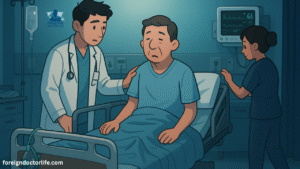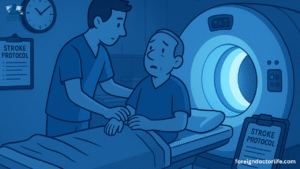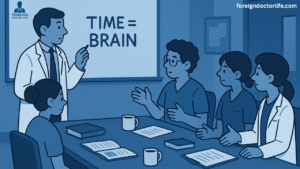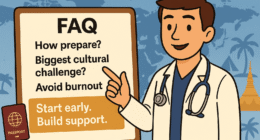The First Emergency Case as a Doctor
Every doctor has a first case that never leaves them. Mine was a first emergency case as a doctor involving a middle-aged man rushed in with stroke symptoms.
I had studied the protocols—FAST signs, thrombolysis window, urgent scans—but when you’re standing by the bedside, seeing a patient unable to move half their body, it hits differently. That moment became my emergency room doctor story—and it shaped my journey in medicine.
Walking Into the Emergency Room
The ER doors flew open as the stretcher came in. A man in his fifties was slumped to one side, his speech slurred, his right arm limp. His family followed, their voices urgent:
“Doctor, he was fine this morning. Suddenly… he couldn’t talk.”
The room filled with urgency. The monitors beeped, nurses prepared IV lines, and my senior’s eyes met mine—it was time.

The Patient I Will Never Forget
This was my unforgettable first ER case.
The man’s gaze darted around, frightened, trying to communicate but trapped by his failing speech. His wife clutched his hand, whispering prayers, tears rolling down her face.
I checked the FAST signs:
-
Face: drooping on the right.
-
Arms: weakness, no lift on the right.
-
Speech: slurred, almost unintelligible.
-
Time: onset—just 45 minutes ago.
It was clear. Stroke. And we were within the golden window.
How I Handled My First Hospital Case
This was my first case as a junior doctor, and the protocol kicked in.
Airway & Breathing
Stable, but oxygen started.
IV Access
Secured swiftly by the nurse.
Urgent Imaging
I prepared the patient for CT brain, my heart pounding as I explained to his family.
Decision Point
If the scan showed no bleed, he would be eligible for thrombolysis.
It was like walking a tightrope between hope and urgency.

The Emotions Behind the White Coat
Inside, I was nervous—this was my real life ER experience. I had rehearsed stroke management countless times in theory, but here was a man whose future—walking, speaking, laughing—depended on what we did in the next few minutes.
I kept my voice steady while explaining:
“Your husband may have had a stroke. We need a scan immediately.”
The wife nodded, eyes wide, clinging to every word. That was the moment I realized medicine isn’t just science—it’s trust.
Lessons From My First Emergency Case
That day, I learned lessons no classroom could teach:
-
Time is brain. Every minute lost means brain cells lost.
-
Communication saves lives. Families need clear, calm explanations in moments of chaos.
-
Teamwork is everything. From nurses to radiology to seniors, it’s never one person—it’s all of us.
-
Hope and reality walk together. Sometimes you win, sometimes you lose, but you always give your best.
It truly became my unforgettable first case.

Life as a Doctor: More Than Just Medicine
This hospital experience taught me that medicine is about more than guidelines—it’s about humanity. Stroke doesn’t just affect patients; it affects families, futures, and stories yet to be lived.
This is doctor life: racing against time, fighting uncertainty, and finding meaning in every decision. That patient—and his family—changed me.
This experience also reminded me that being a doctor abroad isn’t just about medicine—it’s about adaptation, trust, and resilience. I shared more about that journey in my post My First 100 Days Abroad as a Doctor.

Conclusion: Why I Will Never Forget This Emergency
My first emergency case as a doctor was a stroke patient who reminded me why I chose this path. The fear, the adrenaline, the relief when the scan confirmed he was eligible for treatment—all of it burned into my memory.
Even now, whenever I hear a stroke code, I remember his face, his wife’s hope, and my own trembling hands finding courage.
It wasn’t just a medical case. It was a defining moment. And that’s why I will never forget this emergency.
💬 Have you ever witnessed or experienced a stroke? What was the first sign you noticed? Share your story below.








4 comments
Thanks for sharing Sir
Thanks
Nice Article
Thanks lots for sharing your experience…